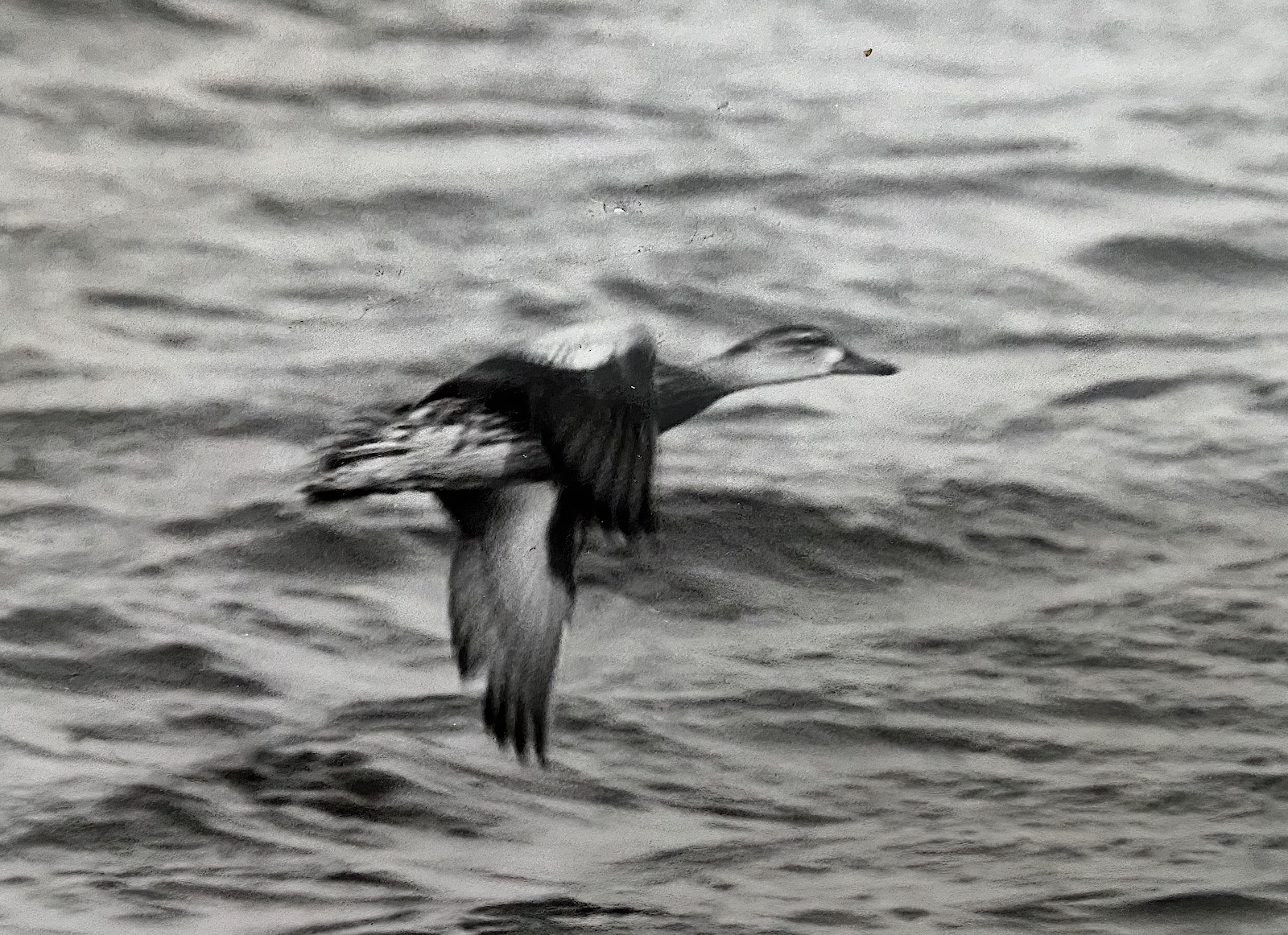Blue-winged Teal Spatula discors
Vagrant. North America.
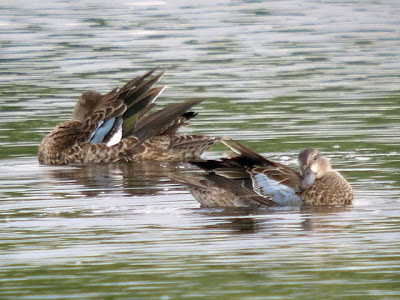
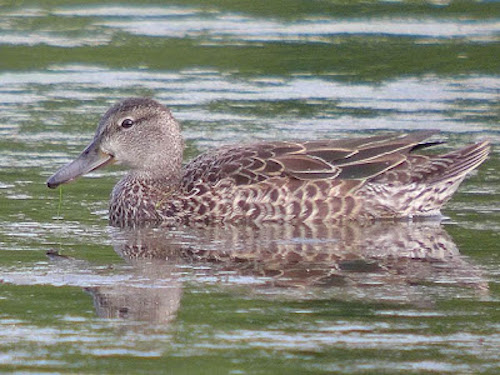
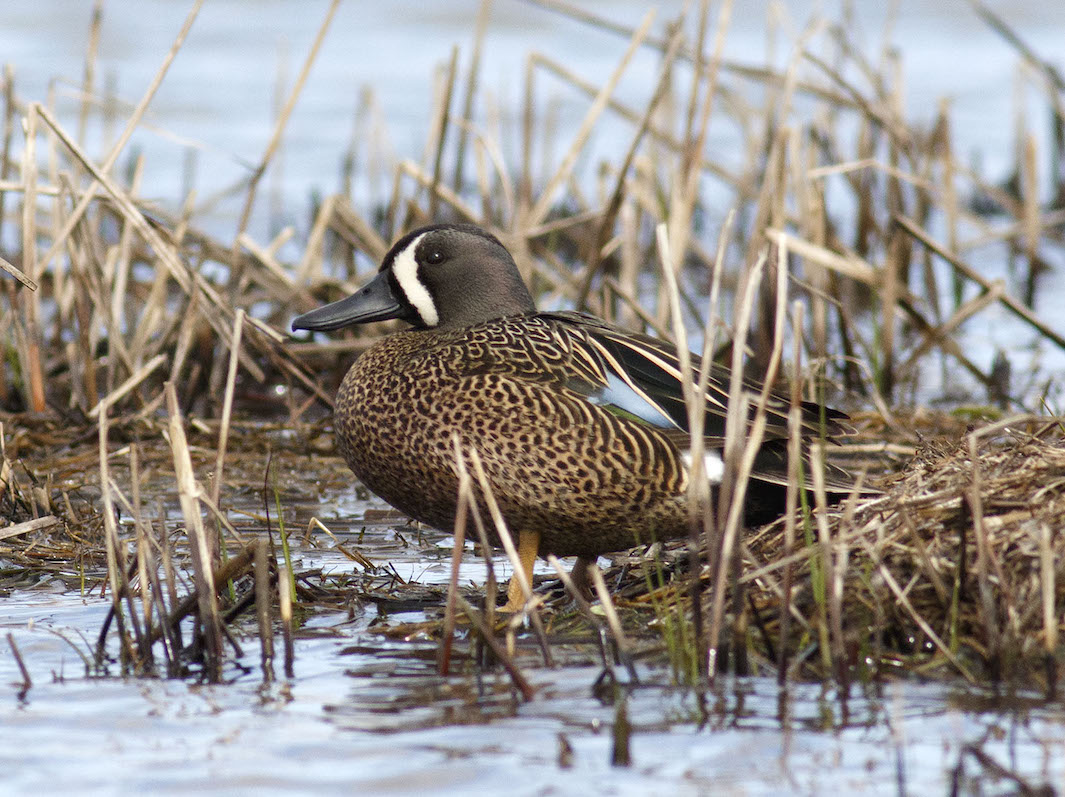
Blue-winged Teal: left/centre, Boultham Mere, Lincoln, September 16th 2013 (Russell Hayes); right, Donna Nook April 25th 2015 (Graham Catley).
Blue-winged Teals are fairly common in wildfowl collections and some suspicion is often attached to sightings, but true vagrancy is evidenced by ringing recoveries between Canada and Europe including three to Britain and Ireland, one of which was in Suffolk. One which was first seen as an immature drake that arrived at a wildfowl collection at Sudbrook Manor, near Grantham in 1941 remained on and off until 1947. Smith and Cornwallis (1955) stated that 'it seems likely to be an escape', and it's extraordinarily long stay adds weight to that and it disregarded for this reason. The first acceptable record was of a male found on a 'fen near Lincoln' in April 1947 and accepted as a probable wild bird by both Smith and Cornwallis (1955) and Lorand and Atkin (1989).
The seasonal distribution of the records involving 13 individuals matches that of British records as a whole, with most appearing in autumn but a smaller peak in spring. The female in 1997 was apparently paired with a drake Shoveler, Anas clypeata. The three together at Boultham Mere in 2013, two males and a juvenile female, was the most remarkable of all the county records to date.
The seasonal distribution of nine records involving 12 individuals in Lincolnshire (see chart) matches that of British records as a whole, with most appearing in autumn but a smaller peak in spring.
| Site | First date | Last date | Count | Notes |
| A fen near Lincoln | 22/04/1947 | - | 1 | Male, treated as separate from the Sudbrook bird; with other wildfowl and waders. |
| Wisbech STW* | 11/09/1978 | 08/10/1978 | 2 | Immature males. |
| Huttoft Pit LWT Reserve | 26/09/1982 | 30/09/1982 | 1 | 1CY male. |
| Messingham SQ | 11/03/1997 | 13/04/1997 | 1 | Female often seen with a male Shoveler. |
| North Somercotes Warren | 28/09/1997 | - | 1 | 1CY, probably a female. |
| Boultham Mere | 13/09/2013 | 28/10/2013 | 3 | One on 13/9, two on 16/9, then 3 from 17/9 onwards, one until 12/11; two ad. males (eclipse) and a 1CY male✝︎ |
| ✝︎ sex determined after advice from Peter Pyle, expert American birder. | ||||
| Middlemarsh Fm, Skegness | 29/06/2014 | 02/07/2014 | 1 | Adult male. |
| Donna Nook | 12/04/2015 | 28/04/2015 | 1 | 2CY+ male. |
| Alkborough Flats | 11/08/2018 | 1 | 2CY male. | |
| East Halton | 15/10/2022 | 20/11/2022 | 1 | 1CY female; present 15-18/10/22; 29/19-02/11; and 19-20/11/2022. |
| Frampton Marsh | 01/05/2023 | 07/05/2023 | 1 | Adult male. |
| Freiston Shore | 11/05/2023 | 14/05/2023 | 1 | Adult male, same as Frampton Marsh bird. |
*There are slight discrepancies between sources over the dates of this record. BBRC states two on September 12th with one staying to the 24th, but others including L&A and Taylor et al. (1999) give the longer period above. BBRC and L&A do not say anything about the birds’ age or sex but Taylor et al say they were two immature drakes.
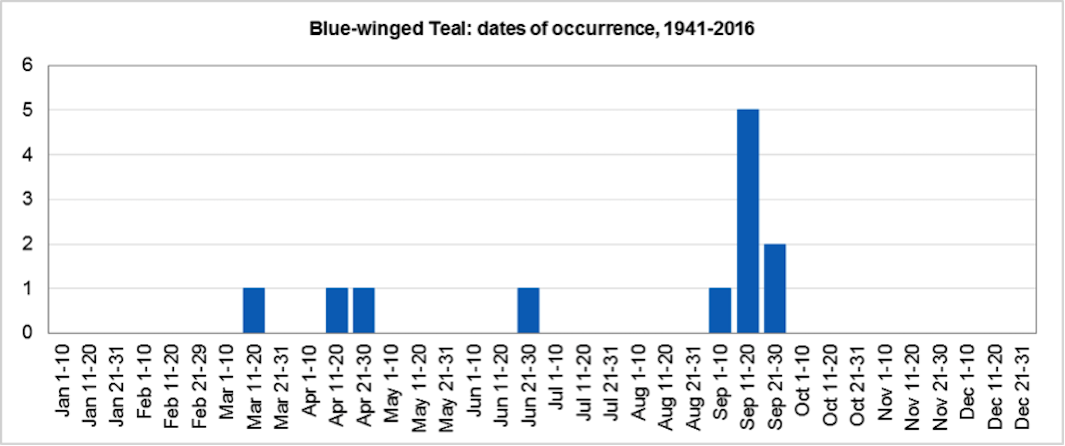
Finder’s report: Blue-winged Teal at Huttoft Pit, September 26th, 1982, third county record.
by R. Bennett and G. P. Catley.
Note: account based on the original BBRC submissions, this was the fourth county record, the first we have on file. The RC (BBRC) report for 1982 noted that the records during 1958-72 revealed small spring and autumn peaks. Since 1972 more knowledge of the female, immature and eclipse male plumages has led to a wider scatter of records: it is extremely rare in winter (only five November to March records), more frequent in spring (12 in April to June), but most numerous in autumn as expected (33 in August to October), with a peak of 17 in September. This pattern is hardly surprising in view of the fact that this is very much the Nearctic equivalent of the Garganey, A. querquedula, and, like that species, might find winter survival here problematical.
Circumstances
A routine day trip around Lincolnshire coastal sites by RB and a novice birdwatcher had produced little of note, partly because of the fierce southerly wind. They arrived at Huttoft at 1.15 pm. And as they approached the smaller of the two pits here, a small duck flew in from the south. In the few seconds that it was seen it in flight the only obvious characteristic was a vivid blue rectangular patch on the median/greater coverts. RB immediately identified it as a Garganey, a bird he had seen at the same site before and one which his companion had never seen before. They cautiously approached the pit and spent the next 15 minutes circling the pit watching the bird as it kept to the edge, flying diagonally away from them to land again or just swimming away along the edge. The wind made it very difficult to hold binoculars steady and no notable features could be seen (no colour was visible on the wing and no obvious facial features other than an indistinct pale supercilium). On returning to their car and consulting Hollom, they both realised that what they had seen resembled Blue-winged Teal more than Garganey. The next day the bird was seen by several other observers and its identity confirmed.
Description
Appearance – looked slightly bigger than Teal, longer, more streamlined, and smooth-looking.
Head – more gently sloping than Teal giving the appearance of dark crown, pale supercilium, dark line through the eye, pale cheeks with dark patch on rear of ear coverts, and narrow dark nape; obvious pale loral spots at base of bill; loral sports at base of bill rather obvious, creamy and well defined; crown from above bill dark brown, same colour going down the nape where it was quite narrow; supercilium pale creamy buff, narrowly flecked darker at rear and underlined by a narrow dark brown eyestripe from base of bill to well behind the eyes, which were dark and quite wide and very obvious pale whitish creamy crescents above and below the eyes. Rest of sides of head and upper neck a pale creamy-buff narrowly streaked with dark brown. There was also a dark brown patch on the rear of the ear coverts, varying in prominence with the light conditions. Bill looked longer than Teal, spatulate, wider just before the tip; ridge and tip blackish, rest of bill bluish-grey; underside of bill, seen when preening, flesh coloured.
Upperparts – mantle dark blackish-brown with narrow pale buff fringes, giving a scalloped effect when seen well. Flight feathers blackish-brown, darker than mantle with narrow whitish fringes, most obvious on tertials. Rump looked paler due to dark brown feather centres broadly edged pale creamy-buff. Tail looked longer tan Teal and extended further beyond the closed wing tips, this being a good feature when the birds are together. Tail feathers dark blackish-brown with narrow buff fringes, this pattern giving rise to a grey coloured look to the tail sides when swimming contrasting with the whitish edge of Teal’s tail.
Underparts – lower breast a dark ruddy brown with some paler feather edges, this colour extended round the sides of the breast and under the upper belly which was steaked ruddy brown on a paler base colour. Sides and flanks prominently patterned with dark brown feather centres with pale buff edges giving a scalloped look to the flanks. Undertail coverts creamy with rows of dark brown spotting. Legs and feet when seen out of water were a dull orange.
Wings – when preening, the following details were seen: underwing showed a fairly narrow but prominent blackish line on the leading edge, formed by the lesser coverts and contrasting with the very white colour of the rest; upperwing forewing all a rather beautiful Shoveler-like blue, perhaps slightly brighter than that species and very different to the rather sober Garganey; outer wing, primaries and secondaries brown; tips (?) of greater coverts black-centred with white fringes separating the blue from the dull green speculum which also had a very narrow pale lower edge only visible in the best conditions.
Scan of the original black and white photograph of the 1982 Blue-winged Teal at Huttoft Pit by Keith Atkin.
References
Rogers, M. J. and the Rarities Committee, with comments by K. E. Vinicombe (1983). Report on rare birds in Great Britain in 1982. British Birds 76 (11): 476-529.
Smith, A.E. and Cornwallis, R.K. (1955) The Birds of Lincolnshire. Lincolnshire Naturalists’ Union, Lincoln.
Taylor, M., Seago, M., Allard, P. and Dorling, D. (1999). The Birds of Norfolk. Pica Press, Sussex.
(Account prepared October 2017; includes records to 2021. Otherwise as per new Birds of Lincolnshire (2021), included September 2022)


